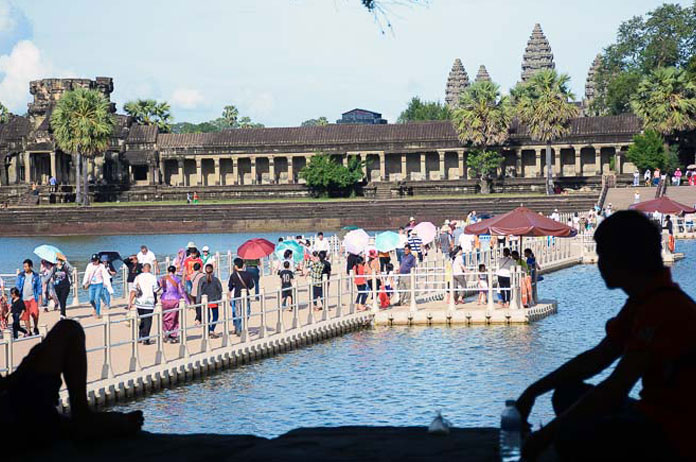Angkor Wat Tourists Floating On The Moat

A temporary floating bridge completed in May over the moat leading to Angkor Wat, while the original is currently closed for repairs, is proving to be popular among tourists visiting the UNESCO heritage site.
Roeung Ry, a professional photographer who takes pictures for tourists for a fee, said his business has never been better. “Many tourists want to see the main Angkor Wat temple from the floating bridge. I guess it’s something new and they’re thrilled standing on it and posing for pictures,” he said. “I don’t think they feel it is dangerous standing on a plastic bridge that’s floating on water.”
The Apsara Authority, the government body that manages the Angkor Archaeological Park in Siem Reap, cooperated with Sophia University in Japan to build the structure, allowing visitors access to the historic site.
Heng Kim Leng, the director of the Apsara Authority’s technical support department, said the bridge, made from polythene air bags, could last for 20 years and was built for visitors to take photographs and admire the ancient temple. He said the air bags’ total area was 1,874 square metres and that one square metre could support 272 kilograms.
“We assume that one person weighs 80kg, so this floating bridge can support a total of 6,371 people at the same time,” added Kim Leng. The floating bridge is located south of “Spean Herl” – the original stone bridge – which now is undergoing a second phase of repairs.
As Sim Makara, from Battambang province, kept her eye on her children jumping up and down on the floating bridge, she said the novelty of it attracted them to Angkor Wat. “Where else can you find a floating bridge like this? I have visited the Angkor temple many times, but in this tour my family and I wanted to see and walk cross the floating bridge,” she said.
Long Kosal, spokesman for the Apsara Authority, said the number of tourists visiting Angkor Wat did not change despite the picturesque Spean Herl undergoing repairs. “Tourists, particularly local tourists from Siem Reap and other provinces, visit Angkor Wat to experience the floating bridge. So it is a tool to attract more visitors to visit Angkor,” he said.
The original bridge, west of the temple, is about 190 meters long. The first phase of repairs was completed in 2007 by the Apsara Authority and Sophia University, which spent 12 years repairing 90 metres. In May, the Apsara Authority and its Japanese counterpart signed an agreement and held a ground-breaking ceremony for the second phase of repairs, which will fix 100 metres and is estimated to take four years.
Following a spike in Angkor Archaeological Park ticket prices, the government has seen a steep rise in revenue from the park in the first half of the year compared with the same period in 2016. Angkor entrance passes earned $52 million in the first six months of 2017, a 67 percent rise compared with the same period in a year earlier. Tourist arrivals to the park also rose by 13 percent, according to report from the Angkor Enterprise.
In February, the government set new prices of Angkor entrance passes for foreign tourists – a one day entrance pass increased to $37 from $20, a three-day pass $60 from $40, and a week long pass to $70 from $60. Of the new prices, $2 is also contributed from each ticket to the Kantha Bopha Children’s Hospitals.
In May, Angkor Wat was named the world’s number one landmark in TripAdvisor’s 2017 Traveller’s Choice awards. The World Heritage site beat competition from the likes of India’s Taj Mahal, Peru’s Machu Picchu, and St Peter’s Basilica in the Vatican City to take the top spot.
Thourn Sinan, chairman of the Pacific Asia Travel Association Cambodia, said the award would help attract a new wave of foreign tourists. “It is a good way of promoting our country to the world,” he said.